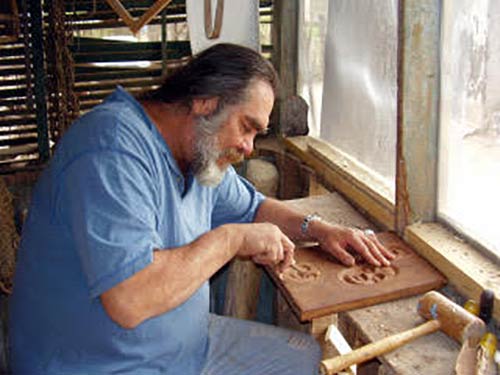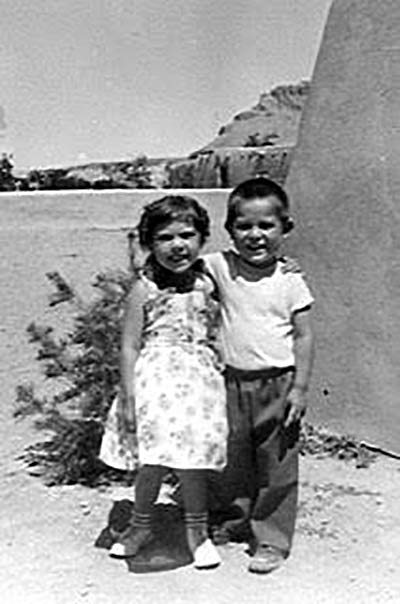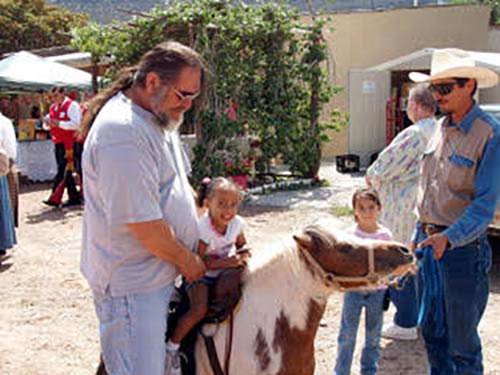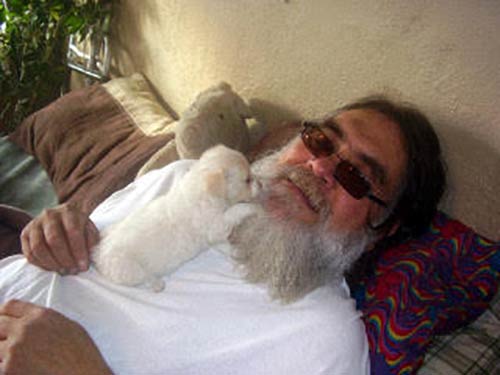|
By Jessica Rath There are so many fabulous people in our little town of Abiquiú. When I chatted with Analinda Dunning a little while ago, her late husband Napoleón Garcia’s oldest son, Leopoldo Garcia (called Leo, for short), joined us and shared many stories with me about his life and his family. I remember my first Abiquiú Studio Tour, in 2001, and I visited Leo’s gallery, the Galeria de Don Cacahuate, the peanut gallery, as he explained. I had just moved to New Mexico from California; the carved wooden sculptures of Saints – bultos – and the paintings (retablos) were a form of folk art new to me. I learned from Leo that he has continued a tradition that had been in his family for generations. “My uncles, my father's brothers, were all woodcarvers”, Leo told me. “On his side of the family, the Garcias, they were all sheep herders. They would carve wood when they would take care of sheep. But it ran on both sides of the family. On my mom's side, the Ferráns, they were French and Spanish. They were painters, they still are. My cousins and others from that side are painters. But I taught myself the basics of woodcarving”. Analinda elaborates: Leo’s grandfather on his mother's side is Joe Ferrán, the Gym in the Abiquiú Pueblo is named after him. Joe Ferran collaborated on many village projects in the first half of the 20th century with Martin Bode. Leo inherited artistic talents from both sides of his families. Leo’s children continue the family tradition: “My granddaughter Gabby is a fantastic artist, and my son, Joe Paul, is an artist as well. The only one in my immediate family that doesn't do any art is my daughter Jennifer. But Jennifer excelled in other things. She has been a long-time department manager at a Smith’s Grocery in Albuquerque. She owns her own home and is the caregiver for her younger brother, Leo. My son Leo was a fantastic artist. We did a lot of art shows together.Actually, he was better than me. But then he got sick. He's still doing art, where he lives in Albuquerque. My son Joe Paul also does wood carvings. My brother Howard and some of my other brothers also carve! So I’m really fortunate to be part of this inspiring family.” Leo is proud of his gifted children. “My granddaughter Gabby, she’s the youngest, she just turned 19 and she will go to the design school in Santa Fe, where she plans to study computer graphic arts”. Leo has two sons and a daughter, and a son who passed away. And he has four grandchildren; they all live around Abiquiú. Somehow, I assumed that Leo also had lived around Abiquiú all his life, but was I ever wrong! He actually had moved all across the United States. While in the US Navy, he met his wife on Padre Island near Corpus Christi, Texas, where he ended up because he always loved the ocean, he told me. They married in 1975 and moved to Gulfport, Mississippi, where his wife’s family lived. But they didn’t stay there long, and in the late 80s or early 90s they returned to Abiquiú. When he was in the military, Leo was stationed in Alameda/California. He often visited Berkeley, where I was living then – who knows, our paths may have crossed! “I loved the community in Berkeley, Telegraph Avenue, the UC Berkeley Campus. I remember the Hare Krishnas hopping and dancing around; they were so much fun to watch!” Well, this certainly evoked my memories and we could have reminisced for hours. But Leo has another feather in his cap I knew nothing about: he owned a plumbing business, and he also taught plumbing at the Northern New Mexico Community College for almost ten years. “I had my own plumbing business, I did the plumbing for all the big houses up in the mountains. I took a class in El Rito, way back in the early 70s. And then later on a friend of mine, Lorenzo Gonzalez who was the director of the industrial arts programs, asked me if I would be willing to become the plumbing instructor. I told him that I’d love to. So I would work in El Rito for the Northern New Mexico Community College, and I received my certification from the University of New Mexico. I taught there for almost ten years”. “I taught a lot of kids from around here; of course, they're not kids anymore. Some of them have gone on to have their own big plumbing businesses and are doing really well for themselves. It often happens that I’d run into one of them and he’s telling me, thank you for what you taught me. That gives me a lot of satisfaction. I also taught art classes in the Pueblo right at the Parish Hall. Over the years, I've taught a lot of people how to make St. Francis bultos, and retablos, and other stuff. Some of them have gone on to become really famous artists and make pretty good money.” “After I stopped teaching at the Community College I returned to my plumbing business, and I did this until I got badly hurt on a job; I ruptured some discs in my back. That’s when I decided to retire, and I opened my gallery which I’ve run for over 30 years now.” Leo loves Abiquiú. All his brothers and sisters also live around Abiquiú. His father, Napoleón Garcia, had ten children, three daughters and seven sons. Except for one sister who fell in love with El Rito and lives there now, and another sister who lives near Truchas, they all live close to Leo.I learned more about Napoleón as well: he had worked in Los Alamos for over 30 years. “When he retired, we talked him into opening a gallery, his own gallery, because he was always telling us all these stories. So he opened up the gallery, and before you knew it, people were coming from all over the world to hear my father's stories. He lived for another 20 or 30 years after he retired, whereas many of the people that he worked with in Los Alamos passed away soon after retiring. Well, my father was a very unusual character. After he opened the gallery he started carving, making ladders, bultos, and carving other things, painting things. He made a lot of walking sticks. Carving started to come out of him, you know what I'm saying? So, he did carve, and I learned a lot from him, from him and from my grandfather, especially when it comes to work ethics.” “People still come to the gallery looking for him. It kind of makes me sad, but it also makes me happy that people are still thinking about him.”
Thank you, Leo, for sharing your life with me. Abiquiú is like a rich tapestry with many distinct illustrations, all woven together. Only when one looks closely can one distinguish the details and begin to get a better understanding. A warm Thank You to Analinda Dunning for providing the lovely photographs.
3 Comments
Paula Davis
2/9/2024 09:19:15 am
Last September another artist and I visited Leo Garcia's studio in Abiquiu and admired his carvings and artwork by other family members. Such a creative family! Leo was very gracious and had lots of stories to tell. If I had not been flying home, some of the larger carvings there would have been wonderful to have bought.
Reply
Jessica Rath
2/17/2024 11:00:55 am
Thank you, Paula -- a creative family indeed, and Leo is passing the artistic talents on to his children. I hope you will visit again!
Reply
Paula Davis
2/21/2024 05:36:55 am
Absolutely will! And when I do, I'll stay at Leo's brother's AirBnB nearby -- Domminic Garcia. A great little casita! Your comment will be posted after it is approved.
Leave a Reply. |
Submit your ideas for local feature articles
Profiles Gardening Recipes Observations Birding Essays Hiking AuthorsYou! Archives
October 2025
Categories
All
|







 RSS Feed
RSS Feed